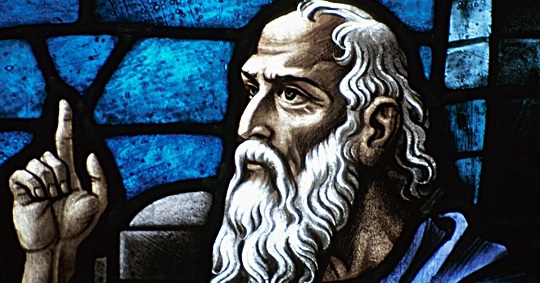This article is part of a series on Old Testament Christophanies. For important background information, see An Introduction to Old Testament Christophanies–with Justin Martyr.

When Daniel was a young man, the mystery of Nebuchadnezzar’s dream was revealed to him in a night vision (Dan 2:19). The dream included a stone that was cut out of a mountain without hands (Dan 2:34, 45), which was emblematic of the coming Messiah and His kingdom (e.g., Ps 118:22; Isa 28:16; Matt 21:42). Fifty years later, Daniel was given his own prophetic dream about the coming Messiah (Dan 7). In the dream, he saw the “Son of Man,” who is the incarnate Son of God (e.g., Mark 14:61–62; John 1:51), coming with the clouds of heaven and being presented before the “Ancient of Days,” who is God (see Isa 43:13; 57:15). The Son of Man was given an everlasting kingdom (Dan 7:13–14, 27).[1] But while Daniel had prophetically seen the Messiah, it wouldn’t be until he was in his eighties that he was actually visited by the Son of God.
In Daniel 10, a message was revealed to Daniel in “the third year of Cyrus king of Persia,” which was 536 BC. The message concerned a time of great conflict yet to come. Daniel understood the “message” and the “vision” (v. 1). He would receive a revelation that was both verbal and visual.
Daniel had been mourning and fasting for three weeks leading up to his vision. “On the twenty-fourth day of the first month,” the prophet was near the bank of the Tigris River (vv. 2–4). The “first month” was Nisan, during which the Passover and the Feast of Unleavened Bread were observed (Exod 12). Daniel’s three weeks of mourning, fasting, and praying (v. 12) seem to have been his way to honor the feasts. And in return, the Lord honored Daniel by appearing to him:
I lifted my eyes and looked, and behold, there was a certain man dressed in linen, whose waist was girded with a belt of pure gold of Uphaz.[2] His body also was like beryl, his face had the appearance of lightning, his eyes were like flaming torches, his arms and feet like the gleam of polished bronze, and the sound of his words like the sound of a tumult (Dan 10:5–6).
Linen was the clothing of priests (e.g., Exod 28:39–42; Lev 16:4; 1 Sam 2:18), while a waistband interwoven with gold material was worn by the high priest (Exod 28:8). The clothes on this glorious man pointed to a heavenly priesthood. Jesus is our “great high priest who has passed through the heavens” (Heb 4:14). The man’s body looked like a brilliant gemstone, shining with God’s glory. And like the facets of a gemstone, the various parts of His body refracted the light of His glory in different ways.
The description of this “man” is in harmony with the description of the “man” on the throne in Ezekiel 1:26–28, who was the Son of God. And there are striking similarities, in appearance and speech, between this man and the glorified Christ, the “one like a son of man,” seen by the Apostle John on Patmos (Rev 1:13–16). The man Daniel saw was dressed in linen; Christ was “clothed in a robe reaching to the feet.” The man wore a belt of pure gold around his waist; Christ wore a “golden sash” (or “belt” [Gr. zóné]) across His chest (worn horizontally). The man had a face that appeared like lightning; Christ’s “face was like the sun shining in its strength.” The man had eyes like flaming torches; Christ’s “eyes were like a flame of fire.” The man’s arms and feet gleamed like polished bronze; Christ’s “feet were like burnished bronze, when it has been made to glow in a furnace.” The man’s voice sounded like a multitude of people; Christ’s “voice was like the sound of many waters.” These slightly different but corresponding descriptions show that two different men described the same divine person from their own perspectives. The final book of the Bible has given us a fuller revelation of the man in Daniel 10:5–6. He was the One later seen on Patmos, the One who is called the Son of God (Rev 2:18). In his commentary on Daniel 10:5, Poole advised his readers to “see Rev. i. 13–17, where the Lord Jesus Christ is described as here in Daniel . . . Now he appeared thus before his incarnation, in the Old Testament, as a prelude of it, as the best expositors grant it.”[3]
The most notable feature of the man Daniel saw was His face, which “had the appearance of lightning.” At the transfiguration of Jesus, “His face shone like the sun” (Matt 17:2). These descriptions denote especially brilliant light. The face of Moses reflected God’s glory (Exod 34:29), whereas the face of the Son of God shines with His own glory. The face is the most expressive part of the body. If any part of the Son radiates more of God’s glory than the rest of His body, it would be His face.
Daniel alone saw the vision, while the men who were with him were overcome with dread and they ran away to hide. Daniel continued to see the vision; his face grew pale, and he was drained of his strength. As Daniel listened to the glorious man’s voice, he fell into a “deep sleep” with his face to the ground (vv. 7–9). Similarly, when John saw the glorified Christ on Patmos, he “fell at His feet like a dead man” (Rev 1:17). Seeing and hearing the Son of God in His glory caused Daniel to faint. And while he was unconscious (or semiconscious), the glorious man departed.
By the time Daniel awakened, a different visitor had arrived. Continuing in Daniel 10, a hand touched Daniel and lifted him to his hands and knees. The visitor then spoke to Daniel, calling him a man greatly loved (by God). The visitor told Daniel to pay attention to what he was about to say, and to stand up, “for I have now been sent to you” (vv. 10–11). This visitor was an angel sent to Daniel by God or specifically by God the Son. In contrast to the detailed description of the glorious man, the angel is only said to look like a human being (vv. 16, 18). The angel was probably Gabriel since he had earlier appeared to Daniel as a man and been instructed to give him understanding (Dan 8:15–17; 9:21). The angel told Daniel that from the first day he had set his heart on understanding and on humbling himself before God, his words were heard. However, the “prince of the kingdom of Persia” had prevented the angel from coming to Daniel for twenty-one days. Only after Michael, one of the chief princes, came to help was the angel able to arrive. The angel explained that he had come to give Daniel an understanding of what would happen to his people in the future (vv. 12–14). The prince of Persia was a fallen angel or demonic entity who was responsible for Persia (see Eph 2:2). A fallen power couldn’t stop God’s Son for a second, let alone for three weeks. Nor would the Son need the help of the archangel Michael to overcome anyone. It is for these reasons that those who mistakenly conflate the glorious man with the angel often fail to recognize the Son of God in Daniel 10.
[1] This part of Daniel’s dream and the corresponding part from Nebuchadnezzar’s dream (Dan 2:34, 45) will be fulfilled at the Second Coming (e.g., Matt 24:30; 26:64; Rev 1:7).
[2] Uphaz was apparently a place from where pure gold came (see Jer 10:9).
[3] Poole, Annotations, 2:840.

You have the sacred secret on this. You will be paid for it. I have a lot to discuss with you. If my message is read, please let’s continue on my email.
“And he said, “O man greatly loved, fear not, peace be with you; be strong and of good courage.” And as he spoke to me, I was strengthened and said, “Let my Lord speak, for you have strengthened me.””
Daniel 10:19
Why would he call an angel Lord?